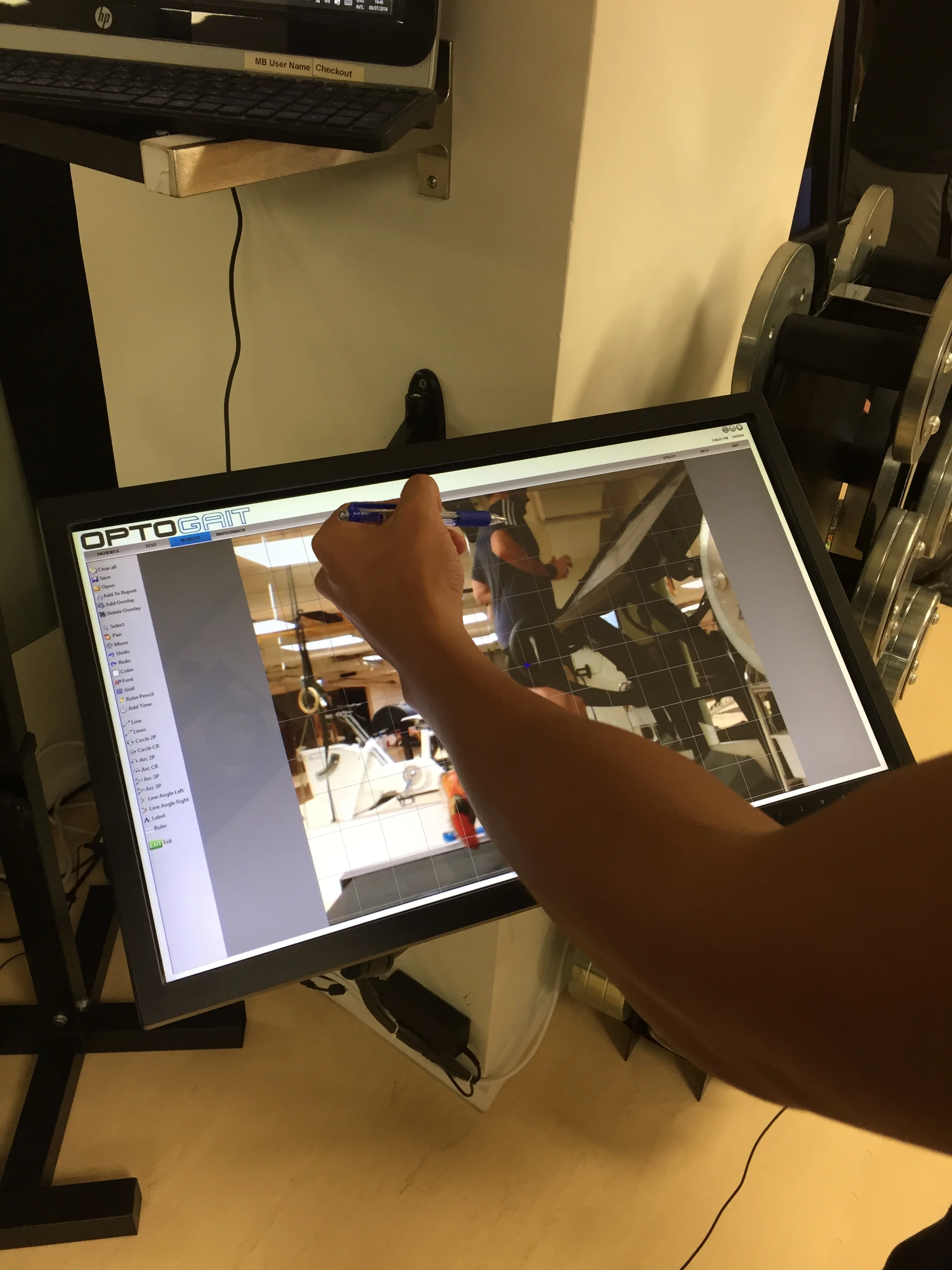Swinging My Hips for the Camera – Unlocking the Secret of my Slowness Part II
While I developed a bit of a habit of writing part ones and then never getting back and delivering part two, this round of Life-Sparring is indeed a sequel to an article dealing with my snail-like running speed.
In the first part, called “Why Don’t I run faster? – Unlocking the Secret of My Slowness (Part I)” I looked at age and weight as obvious factors to explain my diminished ability to run fast, compared to my student days. The research was, however, inconclusive, so I have to dig a bit deeper to unlock the secret.
C'mon, Baby, Do the Loco-Motion: Doing a Professional Gait Analysis
To find more clues to the riddle, I decided to do an analysis of how I run. I mean looking at the actual motion-sequence of putting one foot in front of the other. This is something I’d wanted to do for quite a while, mainly because I fight with some ankle issues and had the general feeling that there might be potential to optimize my running style.
An analysis of one’s running style is usually done in the form of a gait analysis (if you want to get a good basic foundation on gait analysis, I recommend Richard Baker’s introduction). I had never done a real gait analysis other than those simple treadmill runs in a sport shop.
After some brief research and email interaction with two vendors offering a gait analysis in Hong Kong, I settled for Joint Dynamics in Central, a specialist in physiotherapy, rehabilitation and personal training, well connected in the Hong Kong running scene.
Joint Dynamics does a gait analysis using a treadmill equipped with the OptoGait system, a combination of two high-resolution cameras (one filming from the side, one from behind) and two bars with 96 LEDs each on opposite sides of the treadmill.
After arriving at the JD premises and settling my charges (HK$1,400 / US$180; I paid the regular price), I was picked up at the reception counter by Kieran, JD’s manager of rehabilitation. After changing into shorts in a treatment room, I stepped toward the treadmill in the corner of the main gym room.
I brought two pairs of shoes for the test: my current street running shoes—slightly banged-up Brooks Glycerine 12, bought in 2014 and with more than 900 km, near the end of their useful life—and a brand new pair of Merrell Waterpro Maipo, water sport shoes that I use as light and extremely breathable flat trail running shoes.
The test was as easy as it gets. Starting with the Brooks, I ran a short warm-up and then settled at a speed of 8 km per hour (pretty much my normal speed for a relaxed jog) for another 10 minutes. After completing the 10 minutes, I changed shoes to the Merrell hikers and hopped back on the treadmill for 10 minutes with the other shoes. Why 10 minutes? Because movement patterns change when muscles are starting to tire.
After a short cool-down and a cup of water, it was time for a look at the pitiful footage and a first quick analysis on the spot.
The Good, the Bad, the Ugly – Stiff Hips and Shortened Steps
Starting with the relatively obvious, the first comment Kieran made was that I have a preference for a slow running pace. Well, actually, my preference is to run as fast as Haile Gebrselassie; I just somehow struggle in doing so. But, well, I got what he wanted to say. I am aware that I am slow.
We then watched me running in slow motion, stopping periodically and discussing aspects of my movements.
On the good side, I am a midfoot striker and the landing point of my steps just under my torso is just fine.
On the bad side, I show a decreased midfoot eversion (as far as I understand it, I stay flat-footed on the ground, not pushing off) and reduced internal rotation of the shin during the stance phase (the time my feet spend on the ground) which reduces the forward propulsion and increases the pressure on the ankles. I also display a mild hip drop on both sides, which increases stress in the joints, can lead to muscle fatigue (due to compensation) and lowers the running efficiency.
And on the ugly side, I display a severely reduced hip mobility and stiffness through the spine that reduces my step length, which in consequence slows me down. Ouch.
About a week after the test, I received a two-page summary of the gait analysis that included the above-mentioned points and, in addition, also listed my step length. Surprisingly, the effect of my limited hip flexibility is much more severe on my right-hand side, leading to a much shorter step length with the right foot than with the left foot. In the Brooks runners, I had a step length of 123 cm on the left-hand side and just 114 cm on the right-hand side. The step length is defined by the measurement from either toe to toe or heel to heel, from one foot to the other.
A shorter step on the right-hand side simply means my right foot is placed an average 114 cm in front of my left foot, while my left foot is placed 123 cm in front of my right foot. This does not mean that I am running in circles, but it means I do not run particularly smoothly.
Aggregating my step length leads to an average stride length of 237 cm. A stride is usually defined as the measurement from toe to toe (or heel to heel) of the same foot. So it includes two steps: one left and one right. As stride and step are often used interchangeably in most articles, it is important to understand the difference.
Running speed essentially can be calculated with a very simple formula: Speed = Cadence (stride or step frequency per minute) x Stride Length.
I knew that my running cadence, with around 145–150 steps/minute, is much lower than the gold standard of 180 steps/minute. Since I upgraded in 2014 to a Garmin Fenix 2 running watch, I get cadence data for every run (Garmin cadence data is in strides, not steps, per minute, so a cadence of 74 means 148 steps/min). I, however, had never really taken a look at the length of my stride.
Putting the Numbers into Perspective
Doing some research (Enomoto et al. 2007), it was quite shocking to see that top 10,000-meter runners—despite being much shorter than my 1.86 meters—have a step length almost double mine.
If I compare my best 10,000-meter run in the past seven years to Kenenisa Bekele’s world-record run over 10,000 meters in the 2007 world championships, it’s clear that it is much more my stride length than my cadence that holds me back.
Changing my cadence from 152 to 190 would bring my 10k time down from my current 58 minutes to 46 minutes—about the time I ran 15 years ago. Keeping my cadence stable, but increasing my stride length to match the 4 meters the only 1.60-meter-tall Bekele covers with a left-right step sequence, would improve my time to less than 33 minutes, far below my personal bests.
As a reminder, I am not trying to enter the world elite of long-distance runners, but merely to try to get closer to my old running times. Even just fixing the difference in step length between my right and my left foot (and adding 10 centimeters to my stride) would improve my time over the 10km distance by three minutes.
Unfortunately, I do not have cadence and stride length data from my faster runs during my university time, but it seems pretty likely that a shortened stride may have something to do with the massive deterioration of my running abilities between 2005 and 2009. This was a time where I worked massive hours, first in my own e-business startup in Germany, then as general manager of an e-business company in Hong Kong. I was never particularly flexible, but that I got stiffer over time seems to be highly probable.
A Working Hypothesis and a Silver Lining?
At least I have something to work on. Joint Dynamics Gait Analysis Report recommends I do the following:
- Increase mobility in your ankles in frontal and transverse place predominately. Perform for two weeks and follow up after. Specifically, in the loading and transition phase of running.
- Increase strength of hip stabilizers to improve loading phase stability and propulsion.
- Increase mobility of hips in all three planes to maximize hip range into extension.
For the hips, the above-linked article on Hip Drop (not hip hop) has a few exercise suggestions to improve functional core strength: single keg squats on an elevated platform and leg lifts are what they recommend. I will dive a bit deeper into this topic and try to put together a small workout program. Let’s see if I can improve my running, working on ankles and hips.
As always, I am more than just grateful for any advice, help, constructive criticism or any other form of feedback. Comment here or on Facebook, or tweet or email at me, if you have anything to share.










